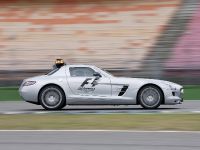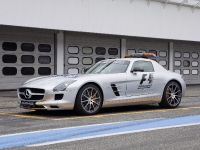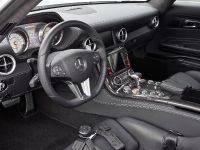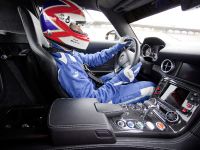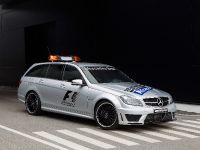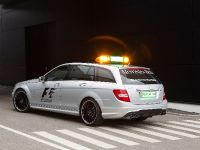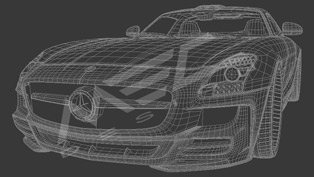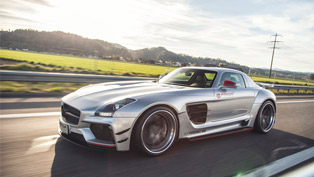2012 Formula 1 supported by Mercedes-Benz SLS AMG Safety Car and C 63 AMG Estate Medical Car
Mercedes-AMG is going to include in the 2012 Formula 1 season Official F1™ Safety Car and the Official F1™ Medical Car based on SLS AMG and C 63 AMG Estate, respectively, thus ensurring maximum safety in extreme conditions. The gullwing model with its one-of-a-kind roof lights and distinctive FIA (Fédération Internationale de l'Automobile) and F1 logos on its aluminium body, has been official Safety Car for Formula 1 for two years already. The SLS AMG is sent out on the track, as soon as the Race Control considers that the safe progress of the race may be impeded. In fact, FIA has entrusted the task of driving the Safety Car to the racer Bernd Mayländer since 2000. In addition, the SLS AMG Official F1™ Safety Car is also on call throughout the race weekend accompanying race series, such as the GP2 and GP3 Series and the Porsche Supercup. In details, during the last years Formula 1, the SLS AMG Official F1™ Safety Car was deployed twelve times. In addition, at the Monaco Grand Prix there were two Safety Car phases, while the Grands Prix in Belgium, Italy, Singapore, Japan and Korea each had just one Safety Car phase. But there was no other year like 2010, when the Safety Car was deployed 21 times, a figure which is an absolute record.
What makes the SLS AMG the perect Safety Car? First, it is low kerb weight, has low centre of gravity and balanced weight distribution, which in addition both are combined with a powerful AMG V8 engine and dual clutch transmission in a transaxle arrangement. Furthermore, the engine, power train, suspension and braking system of the Safety Car are the same as those found in the standard production SLS AMG, with the exception of the newly developed exhaust, which was specifically designed to provide even more emotionally-charged sound experience. In detials, the AMG 6.3-litre V8 engine achieves a peak output of 420 kW (571 hp) at 6800 rpm and a maximum torque of 650 Nm (480 lb-ft) at 4750 rpm. This enables the vehicle to accelerate from 0 to 100 km/h in just 3.8 seconds. In addition, the outstanding SLS AMG's driving dynamics deliver great performance thanks to the aluminium spaceframe body (it weighs only 1620 kg). The low center of gravity has been achieved thank to the dry-sump lubrication system. The installed position of the engine behind the front axle, and the transaxle arrangement of the transmission on the rear axle, have a positive effect on the weight distribution, which is 47/53 percent (front/rear). The AMG SPEEDSHIFT DCT 7-speed sports transmission with dual-clutch technology enables short shifting times. At the same time the integrated mechanical multi-disc differential lock, together with the 3-stage ESP® deliver nothing else but outstanding traction. The suspension of the AMG is with aluminium double-wishbone arrangement, which is usually found in racing cars. In fact, this technology offers a number of benefits like high cornering limits, precise turn-in ability, first-class agility and low mass inertia during fast changes in direction. Additionally, the braking distances are minimised and resistance to fading is maximised due to the high-performance AMG ceramic composite braking system. The SLS AMG also features weight-optimised 10-spoke forged wheels fitted with size 265/35 R 19 (front) and 295/30 R 20 (rear) tyres.
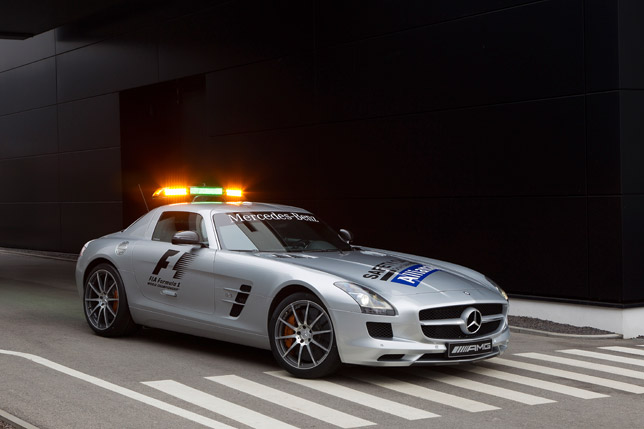
What makes the Official F1™ Safety Car different from a standart production SLS AMG is the roof light bar. It boasts an aerodynamically efficient profile and sits on a carbon-fibre hood. All of the bar's light functions are handled by LEDs; they offer a fast response time and low power consumption. In particular, the two centrally positioned green lights on the front and rear are lit up when the gullwing model joins the field at the start of a Safety Car phase. Permanent green is the signal for all Formula 1 drivers to overtake the Safety Car. On the other hand, the orange light are switched on, as soon as the Safety Car has positioned itself in front of all of the Formula 1 racing cars. The flashing orange lights on the outer ends of the bar indicate that no overtaking whatsoever is allowed. In additiom the roof light bar also incorporates a camera, and a second one is located next to the rear number plate, which allows the driver and co-driver to monitor the Formula 1 cars behind via a screen in the cockpit. There is also special number plate on the rear and 700 green LEDs. They provide additional safety in darkness or wet weather. Another important feature is the stroboscopic lights in the headlamps and tail lights, which are activated permanently and provide a signalling function.
How about the interior of the Safety Car? Well, it is not much different from a standard production model: it includes sport bucket seats with black leather upholstery. On the right side of the AMG DRIVE UNIT there are four coloured buttons which are used for controlling the various light functions and the signal horn. The centre console is also finished in carbon-fibre. The steering wheel in wrapped leather/Alcantara and has a specially contoured grip area, a high-grade metal insert and a 370 mm-diameter rim with a flattened lower section. The seven gears of the dual-clutch transmission are changed using the two high-grade metal shift paddles. Furthermore, two central monitors in the cockpit are used to monitor the progress of the race.
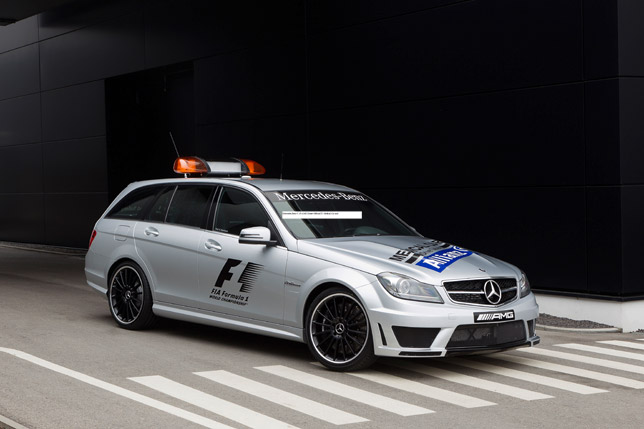
To accompany the SLS AMG Official F1™ Safety Car in the 2012 season, Mercedes-AMG has provided the Official F1™ Medical Car, which will be responsible for ensuring a rapid emergency response if an event of accident occurs. The C 63 AMG Estate is perfectly equipped and provides outstanding driving dynamics: it includes the AMG 6.3-litre V8 engine with the AMG Performance package, which produces 358 kW (487 hp). In addition, the forged pistons, connecting rods and lightweight crankshaft have been adopted from the drive system of the gullwing model. The lower inertia of the components, allows the naturally aspirated eight-cylinder engine to rev freely and respond with even more agility. What makes the car different from a standart C63 AMG, is the variable intake manifold, which lurks beneath the bonnet in a titanium grey paint finish. It helps to accelerate the vehicle from 0 to 100 km/h in only 4.4 seconds. The engine is mated to the standard AMG SPEEDSHIFT MCT 7-speed sports transmission, with wet start-up clutch, four driving modes, a double-declutch and a RACE START function. The excellent driving dynamics are also ensured by the adjustable coil-over suspension. The car sits on the AMG light-alloy wheels, painted in matt black with high-sheen rims and fitted with size 235/35 R 19 (front) and 255/30 R 19 (rear) tyres. The vehicle also has a differential lock and the 3-stage ESP®. Maximum durability is provided by the optimised coolant, engine oil, transmission fluid and power steering fluid cooling. Visually, the Medical Car resembles the Safety Car, and the main reason for this are the light bar on the roof, the FIA and F1‑logos, the stroboscopic LED lights at the front and rear, and the rear number plate illuminated with LEDs and with "Medical Car" lettering. Furthermore, four AMG sports bucket seats with six-point seat belts, two monitors integrated into the centre console for monitoring the race and a radio set for communicating with Race Control distinguish the interior of the Official F1™ Medical Car from that of the standard production C 63 AMG Estate. Of course, there is plenty of space for all of the emergency equipment.
Source: Mercedes-Benz


